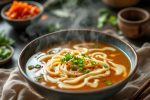What Is the Difference Between Soba vs Udon Noodles
Craving noodles but unsure which type to choose? This guide unravels the delicious differences between soba and udon. Discover the unique nutty flavor and chewy texture of buckwheat soba, perfect for both hot broths and cold dipping sauces. Explore the soft, thick wheat-based udon, ideal for comforting soups and stir-fries. Learn about their ingredients, popular dishes like zaru soba and kake udon, and even gluten-free options. Dive in and find your perfect noodle match!
Important information
- Soba noodles are made from buckwheat flour, giving them a nutty, earthy flavor and a firmer texture. They are thinner than udon noodles.
- Udon noodles are made from wheat flour, resulting in a mild flavor and a thick, soft, and chewy texture.
- Both soba and udon are versatile and can be served hot in broths or cold with dipping sauces. They can also be stir-fried.
- For a gluten-free option, choose 100% buckwheat soba noodles. Regular udon contains gluten.
- Soba is higher in fiber and some vitamins, while udon is typically lower in calories.
What Is the Difference Between Soba vs Udon Noodles?
Soba Noodles
Soba noodles, made from buckwheat flour, offer a unique nutty flavor and satisfying chewiness. They are incredibly versatile and can be enjoyed in hot broths or with chilled dipping sauces.
Udon Noodles
Udon noodles, crafted from wheat flour, are thick, soft, and have a mild flavor while still retaining a pleasant chewiness. Udon is a popular choice for various hot soup dishes.
Understanding Udon Noodles
Thick, white udon noodles are a Japanese staple made simply from wheat flour, water, and salt. Their chewy texture and mild flavor make them incredibly versatile. Enjoy udon hot in broths and stir-fries, or cold with a flavorful dipping sauce for a refreshing meal. Udon offers a satisfying culinary experience.
Ingredients and Composition
Udon noodles are made with only a few simple ingredients: wheat flour, water, and salt. Sometimes, a touch of potato starch is added.
Texture and Flavor
Udon noodles are thick, soft, and chewy with a pleasantly mild flavor, making them incredibly versatile. They pair well with a variety of broths and sauces.
Soba noodles are thinner with a chewier texture and a distinct nutty, earthy flavor.
Common Serving Styles
Udon noodles offer remarkable versatility. They can be enjoyed hot in flavorful broths, such as the simple dashi-based kake udon or the hearty miso nikomi udon stew. Another popular choice is kitsune udon, featuring sweet inari age. Cold udon dishes are equally delightful and are often served with a dipping sauce. For a different experience, try stir-fried udon, showcasing yet another facet of this noodle’s adaptability.
Hot Udon
- Kake udon: simple, dashi-based broth.
- Miso nikomi udon: hearty stew.
- Kitsune udon: features sweet inari age.
Other Udon Options
- Cold udon: served with a dipping sauce.
- Stir-fried udon: showcases the noodle’s adaptability.
Exploring Soba Noodles
Soba noodles, crafted from buckwheat flour, boast a distinctive nutty flavor and a color palette spanning from light to dark brown. Pure buckwheat soba, known as juwari soba, delivers the most authentic taste experience, while blends with wheat flour are also common.Their subtly coarse, chewy texture harmonizes with the earthy, nutty notes inherent in buckwheat. This distinct flavor profile truly sets soba apart.Soba’s versatility makes it a star in both hot and cold dishes. Enjoy them in comforting broths, vibrant stir-fries, or chilled, like the summer favorite zaru soba served with a dipping sauce. Other popular choices include tsukemen soba (dipping soba) and the savory yaki soba (fried soba).
Ingredients and Composition
Udon noodles are made with just wheat flour, water, and salt.
Soba noodles are primarily made with buckwheat flour and water, though sometimes wheat flour is added.
Texture and Flavor
Udon noodles are soft and chewy with a mild flavor.
Soba noodles have a firmer texture and a distinct nutty, earthy taste.
Common Serving Styles
Udon noodles offer remarkable versatility. A simple yet satisfying option is kake udon, served hot in a classic dashi-based broth. For a more substantial meal, the rich stew of miso nikomi udon comes packed with vegetables and a soft-boiled egg. Alternatively, kitsune udon features flavorful inari age in a savory broth. For a refreshing change, try cold udon served with a variety of dipping sauces.
Comparing Soba and Udon: Key Differences
Soba Noodles
Soba noodles are made from buckwheat flour, sometimes with added wheat flour. For a gluten-free option, choose 100% buckwheat soba. They have a thinner, firmer texture, and a nutty, earthy flavor. Soba offers versatile serving options: hot or cold, in various broths, or dry with a dipping sauce (tsuyu). A popular example is zaru soba, a refreshing cold dish.
Udon Noodles
Udon noodles are made solely from wheat flour. They are thick, chewy, and have a mild flavor. Udon is often served hot, such as in kake udon, a dish featuring noodles in a light, clear broth.
Ingredients
Soba noodles get their unique character from buckwheat flour, while udon noodles use wheat flour. This key difference affects both their taste and texture.
Texture and Flavor
Udon noodles are thick, soft, and pleasingly chewy with a mild, neutral flavor, making them incredibly versatile.
Soba noodles are thin with a chewier texture and a nutty, earthy flavor, making them a popular choice for those seeking a more distinct taste.
Serving Styles
Udon noodles are delicious served hot in flavorful broths, like the popular kake udon and kitsune udon.
Soba noodles offer a more versatile dining experience, enjoyed both hot and cold. Examples of hot soba dishes include tempura soba and tsukimi soba, while chilled options include zaru soba and oroshi soba. Soba’s adaptability even extends to salads, adding a unique twist.
Can Udon and Soba Be Substituted for Each Other?
Udon Noodles
Made from wheat flour, udon noodles have a mild flavor. Their thick and chewy texture makes them perfect for hearty stir-fries. Because of their mild taste, they may require more seasoning.
Soba Noodles
Soba noodles, made from buckwheat flour, have a nutty, earthy flavor. Their thin and delicate texture pairs well with light broths. Soba’s robust flavor may require less seasoning.
Making a Choice: Udon or Soba?
Soba Noodles
Soba noodles offer a healthy dose of fiber, aiding digestion. They also provide vitamins B1, B2, and rutin. For gluten-free needs, opt for 100% buckwheat soba noodles.
- Zaru Soba: served chilled with a dipping sauce.
- Kake Soba: served in a hot broth.
Udon Noodles
Udon noodles are lower in calories but contain more carbohydrates than soba noodles. Standard udon noodles, typically made with wheat, contain gluten. However, gluten-free udon alternatives made from rice or tapioca are available.
- Kitsune Udon: a popular udon dish.
- Yaki Udon: another popular udon dish.
Health Considerations and Nutritional Benefits
Soba noodles, made with buckwheat, offer a healthy dose of fiber, making them a delicious way to boost your intake and support digestive health.
Popular Dishes and Preparations
Udon
Udon, thick wheat noodles, are incredibly versatile. Kake udon features a flavorful broth. Yaki udon offers a stir-fried experience packed with flavor. Kitsune udon includes tasty fried tofu.
Soba
Soba, thin buckwheat noodles, provide a contrasting culinary adventure. Zaru soba is served cold with a dipping sauce. Tempura soba adds crispy tempura. Kake soba, like kake udon, comes in a savory broth.
Beyond these classic preparations, both udon and soba can be enjoyed hot or cold, showcasing their remarkable versatility.
Gluten-Free Options
Looking for gluten-free alternatives to noodles? Traditional udon noodles, made with wheat flour, are not suitable, but soba noodles offer a great solution. The key is choosing 100% buckwheat soba. Carefully check the product packaging to make sure it’s labeled as 100% buckwheat, as some soba noodles contain wheat flour. With 100% buckwheat soba, you will find a delicious and safe option for a gluten-free diet.










